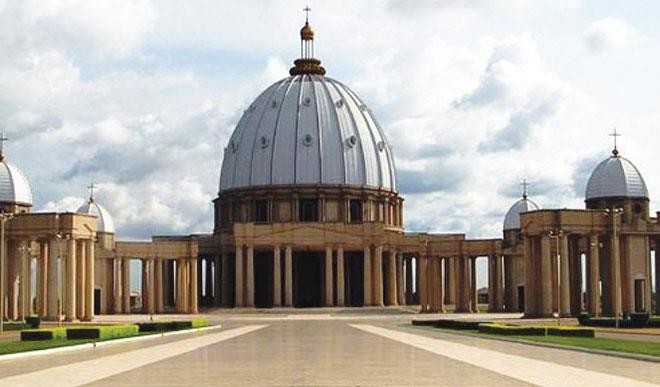Visiting the world’s biggest basilica
When there is a mention of the world’s biggest basilica, most people are not likely think of Africa. But the world’s biggest basilica is in the political and administrative capital of Ivory Coast. Our reporter who recently visited the 18, 000 capacity edifice in Yamoussoukro, reports. ‘There are basilicas and there are basilicas.’ These are […]


When there is a mention of the world’s biggest basilica, most people are not likely think of Africa. But the world’s biggest basilica is in the political and administrative capital of Ivory Coast. Our reporter who recently visited the 18, 000 capacity edifice in Yamoussoukro, reports.
‘There are basilicas and there are basilicas.’ These are the words that temptingly fight to pop out of the mouth of a first time visitor to Basilica of Our Lady of Peace in Yamoussoukro, Ivory Coast – and rightly so because, it is the biggest of all basilica’s in the world – even bigger than the famous St. Peter’s Basilica in Rome.
The pillars, the many stained glasses, the intricately designed air conditioning system, the cupola – I saw them all almost in the same instance. As a Catholic, I didn’t immediately relate with it as a place of worship.
The construction of the basilica was inspired by the Saint Peter’s Basilica, with a dome surmounting a colonnade built in the form of a Latin cross. The entrance into the basilica is serenaded by a large plaza encircled by two more colonnades which support the contrasting four-corner designs on the ceiling. The 272 Doric columns that support the colonnades are made of cement as the tower above my ‘midget’ size at 101 feet.
According to the tour guide Matthias, the late president Félix Houphouët-Boigny offered his coconut farm for the construction of the basilica. The parcel of land was 150 hectares. 130 hectares was used for the church and the rest dedicated to the construction of a hospital which is already in use and a university underway.
The late president commissioned a stained glass window of his image to be placed beside a gallery of stained glass of Jesus and the apostles.
The foreground of the premises is layered with one kilometre of marble from Spain, Italy and Portugal, stretching from the gate to the doors of the church across seven hectares.
In comparison to Rome’s basilica, whose record it broke, the tour guide proudly pointed out the differences.
Although the cupola above St. Peter’s dome in Rome is a bit taller, the crucifix mounted on the top of Our Lady of Peace in Yamoussoukro is taller and makes it the highest in the world.
The basilica’s dome at 489 feet dwarfs that of Saint Peter’s which is 448.1 feet high.
It took the most part of a century to construct St. Peter’s Basilica, but the late Houphouët-Boigny completed the cathedral in three years. It’s been suggested that the late president who was 80 when the construction began, wanted an impressive setting for a grand state funeral.
The late Pope John Paul II in 1985 blessed the first stone which sits beneath the church built between 1986 and 1989. The exterior of the building measures 518 feet while the interior is 393.7 feet high.
Its interior is made up of a rotunda which sits 7, 000 people and 11, 000 standing. It is walled by 24 stained glass windows depicting 24 spiritual elders in the book of Revelations in the Bible. They are all set around 24 pillars. They cover about 7, 400 square metres. There are 20 doors as well as two chapels dedicated to St. Joseph and Our Lady of Peace.
At the top of the 40-metre diameter cupola, the highest yet in the world, is a dove engraved in stained glass – symbolising peace.
Forty-eight solid Doric columns, each one measuring at least 30 metres, embrace the ambulatory all the way to the cupola.
Staircases, cables and elevators are hidden within 12 hollow pillars and reach the Ambulatory of the Apostles and the balconies on the various levels of the roof from where tourists can view Yamoussoukro.
A major sculpture in the church is of a ‘Black Mary,’ carved by a Muslim whom the Virgin visited while imprisoned. Upon his relase, he converted to Catholicism.
The cost of constructing this house of God has never been made public. Houphouët-Boigny, when asked about the source of the money expended on the building, reportedly said: “I did a deal with God, and you wouldn’t expect me to discuss God’s business in public, would you?”
Although the basilica has aroused controversies for its lavish style, which is contradicts the poverty around the country, Ivoirians like Jean Marc – who also works at the Basilica -feel proud of the monument.
He said: “It is very impressionable for us to have this in our country. Also the fact that it too only three years to build the world’s biggest basilica is commendable. we are happy that we have this edifice for touristic purposes and also for spiritual use because there are a lot of pilgrims who visit it at diferent times of the year fo r various spiritual exercises as do those who only want to sightsee.”
